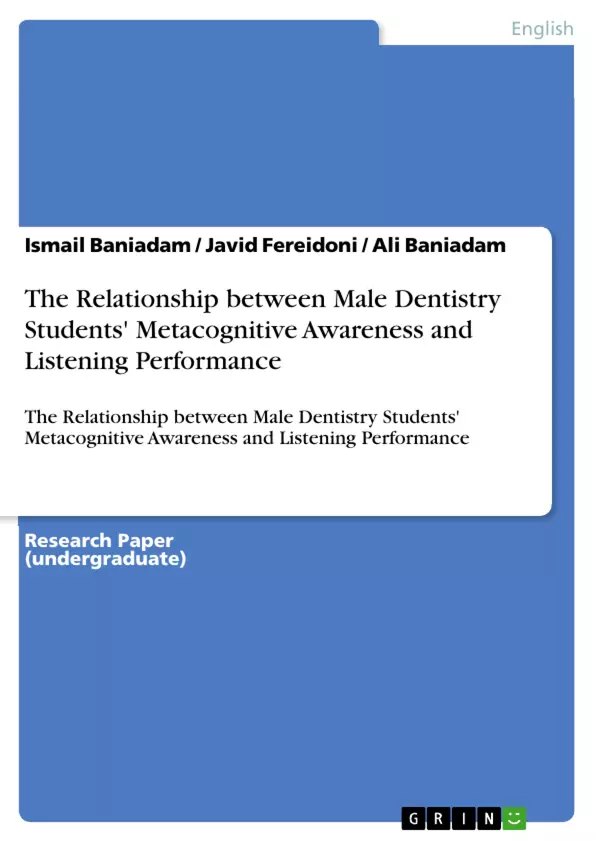Metacognition defined as the knowledge and ability to monitor and control cognitive conditions in the learning process (Flavell, 1979). Listening is the most important skill of the four language skills in both learning and teaching, and plays an important role in our daily life. Although nowadays there is a deeper perception of listening, it needs more attention and research. Accordingly, the present study investigates the relationship between the Metacognitive awareness and listening performance of male Dentistry students in EGP course in Urmia University of Medical Sciences (UMSU). To do so, 50 Iranian male Dentistry students were participated in this study. They completed Metacognitive Awareness Listing Questionnaire (MALQ) and listening section of the final exam. First, the listening section of final exam was applied to the participants at classrooms by the teacher. Immediately after the administration of the examination, the MALQ were conducted. The analysis exposed a weak positive relationship between learners` Metacognitive awareness scores and listening performance. Although correlation was not high, still there is more correlation in problem solving, directed attention and planning evaluation than others.
Inhaltsverzeichnis (Table of Contents)
- Introduction.
- Research question and hypothesis.
- Methodology
- Participants
- Research Design.
- The Metacognitive Awareness Listening Questionnaire (MALQ)
- Listening Section of the final exam.
- Data Collection Procedures.
- Data Analysis
- Result..
- Quantitative data results:.
- Discussion
- Conclusion..
- References
Zielsetzung und Themenschwerpunkte (Objectives and Key Themes)
This study aims to explore the relationship between Iranian male Dentistry students' metacognitive awareness and listening performance in English for General Purposes (EGP). It investigates whether metacognitive awareness contributes to better listening proficiency in this specific group of EFL learners.
- Metacognitive Awareness in EFL Listening
- The Relationship between Metacognitive Awareness and Listening Performance
- The role of Metacognitive Strategies in Listening Comprehension
- Individual Differences in Metacognitive Awareness and Listening Proficiency
- The Impact of Language Proficiency Levels on Metacognitive Awareness and Listening Performance
Zusammenfassung der Kapitel (Chapter Summaries)
The introduction discusses the importance of listening as a language skill and how metacognitive awareness can contribute to effective listening comprehension. It highlights individual differences in learning strategies and the role of metacognition in language learning.
The methodology section details the participants, research design, and data collection procedures. It introduces the Metacognitive Awareness Listening Questionnaire (MALQ) and the listening section of the final exam, highlighting the importance of the correlation coefficient in measuring the relationship between these two variables.
The results section presents quantitative data results, providing insights into the relationship between metacognitive awareness and listening performance.
Schlüsselwörter (Keywords)
This study focuses on the relationship between metacognitive awareness, listening performance, and EFL learners in the context of Iranian male Dentistry students studying English for General Purposes. The study aims to understand the impact of metacognitive strategies on listening comprehension and the role of individual differences in this process. Key concepts include metacognition, awareness, listening, EFL learners, EGP, MALQ, correlation coefficient, and quantitative data analysis.
- Citar trabajo
- Ismail Baniadam (Autor), Javid Fereidoni (Autor), Ali Baniadam (Autor), 2018, The Relationship between Male Dentistry Students' Metacognitive Awareness and Listening Performance, Múnich, GRIN Verlag, https://www.grin.com/document/446151



